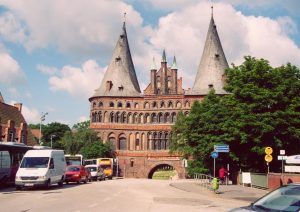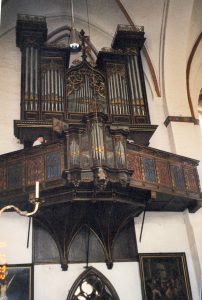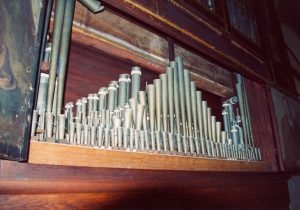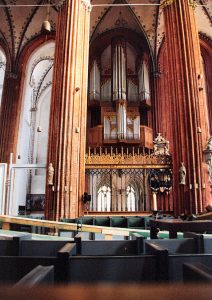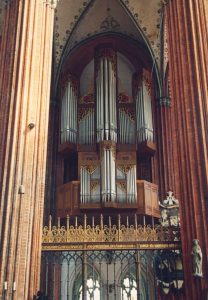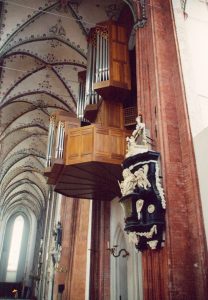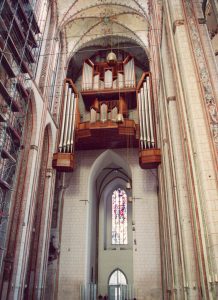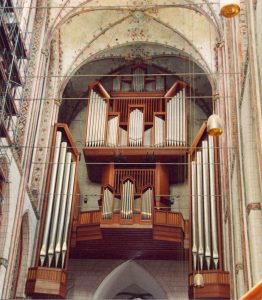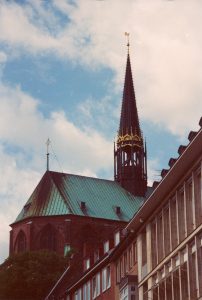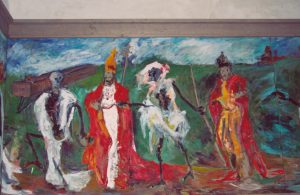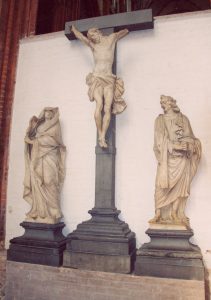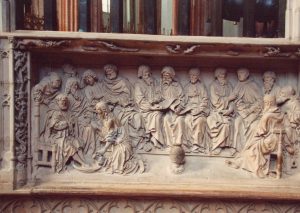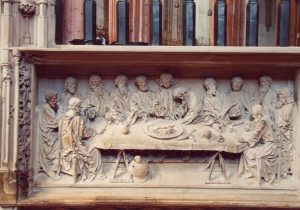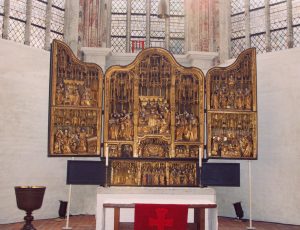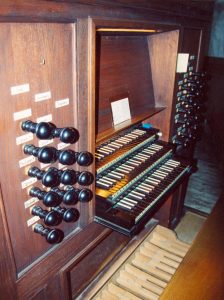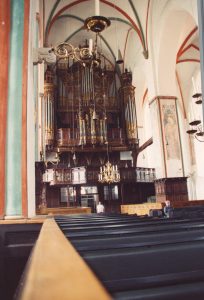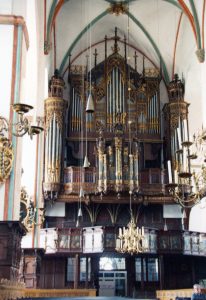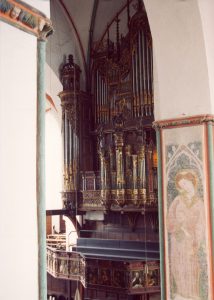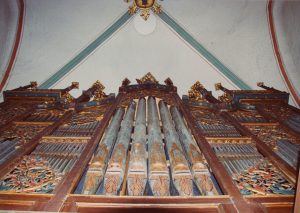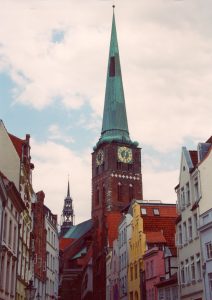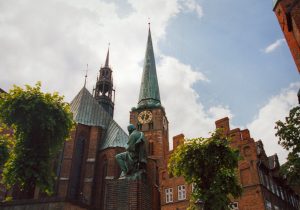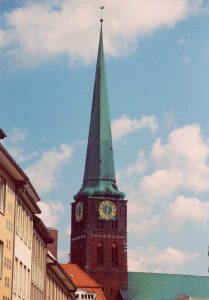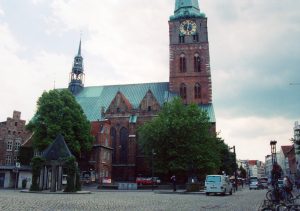Historic Organs of Germany
June 13, 2003
Lübeck
Friday morning we left Hamburg and made the short drive to Lübeck. Another of the Hansa cities, The imposing nature of this surviving gateway into the city should tell you the city was a wealthy one in the seventeenth century. Today Lübeck has much to interest organists, and we made the most of the short time we were able to spend there.
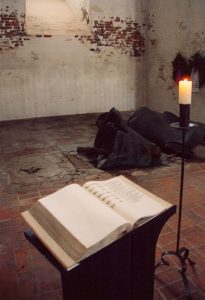 We spent a few minutes as tourists, walking through the old city, but as you might imagine we would do, we went first to the Marienkirche, associated in all our minds with Buxtehude. The organs he played are gone, the “dance of Death” paintings that inspired Distler are gone, along with the Totentanz organ Distler knew. The much larger number of treasures lost when the church was bombed pales in comparison to the number of lives that were lost during one four-hour attack on Lübeck.
We spent a few minutes as tourists, walking through the old city, but as you might imagine we would do, we went first to the Marienkirche, associated in all our minds with Buxtehude. The organs he played are gone, the “dance of Death” paintings that inspired Distler are gone, along with the Totentanz organ Distler knew. The much larger number of treasures lost when the church was bombed pales in comparison to the number of lives that were lost during one four-hour attack on Lübeck.
Among all the beautiful memorials that survive, the most sobering sight we saw—perhaps on the entire trip—was this one. Two bells left where they landed when the tower was destroyed during WWII bombing. The names of the dead are inscribed in the book, and someone lights the memorial candle and turns to page each morning.
If our schedule had allowed us the time, we would have enjoyed playing the two new organs in the church, but that experience will have to wait for another trip.
Our Lübeck appointment was actually in the Jacobikirche, where we once again were handed the keys and told to play as long as we liked. We began at the small organ, this time doing our own playing of individual stops and choruses from the different periods of this instrument’s history. The older stops of the Hauptwerk, dating back to an anonymous builder of the sixteenth century, were reminiscent of the older stops of Steinkirchen, but the Stellwagen stops (from 1637) seemed to be brighter than those of Schnitger. The church is large, acoustically vibrant, and the instrument is placed on the side of the nave. It’s not a particularly large organ, but it’s larger than many organs in the US. Only slightly smaller than the St. Cosmae organ, it’s in a room that easily has four times the volume. The sound is full, round, unforced—and fills the building.
After we had tasted the different flavors of stops and choruses, we played not only pieces contemporary with Stellwagen’s work—and the entire Brustwerk dates back to 1637—but also works by Distler, who was at the Jacobikirche in the 1930s. In fact, the instrument still bears the extended pedalboard (with accompanying pipes) that Distler had added to the organ during his tenure.
At least one person remarked that the sound of his music on that organ was unlike anything he’d heard before. Surely we will have trouble trying to reproduce not only the sounds of the instrument but also the acoustical environment. The brightness of the mixtures on both Brustwerk and Rüpositiv was never intrusive, dominating or forced, and the sound of either chorus provided an ideal foil for the reeds on the other manual. The reeds themselves were further examples of the wonderful variety of color found in seventeenth-century North German organs, without the annoying rattles often found in Neo-Baroque reeds built in the US. I think we all left this instrument with a better understanding of what Distler and his forbears had in mind for their music.
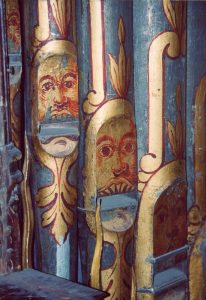 We also took time to play the large organ, a new Schuke (1994) in the old case, which still has the faces painted on the pipes in the nineteenth century. We enjoyed playing a new instrument, and found the most fascinating aspect to be a stop knob linked to the mechanical swell shoe. Once we realized that a registrant could actually work the swell shades while standing before the stop knobs, started playing Brahms, Rheinberger—even a little Franck—with greater ease than ever before!
We also took time to play the large organ, a new Schuke (1994) in the old case, which still has the faces painted on the pipes in the nineteenth century. We enjoyed playing a new instrument, and found the most fascinating aspect to be a stop knob linked to the mechanical swell shoe. Once we realized that a registrant could actually work the swell shades while standing before the stop knobs, started playing Brahms, Rheinberger—even a little Franck—with greater ease than ever before!
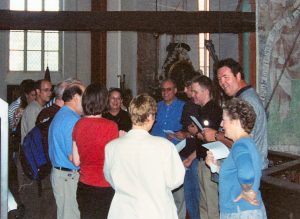 Before we left for lunch in the “Potato Cellar,” a restaurant located in the basement of the Holy Ghost Hospital just a few steps away, we gathered in the choir loft, immediately below the organ gallery, and sang the Tallis setting of “If Ye Love Me.” Most of us are actively involved in both choral and organ music, and the chance to do this in such a flattering acoustical setting was too good to pass up.
Before we left for lunch in the “Potato Cellar,” a restaurant located in the basement of the Holy Ghost Hospital just a few steps away, we gathered in the choir loft, immediately below the organ gallery, and sang the Tallis setting of “If Ye Love Me.” Most of us are actively involved in both choral and organ music, and the chance to do this in such a flattering acoustical setting was too good to pass up.
After congratulating ourselves on the beauty of our voices, and after enjoying a really good meal, we again boarded the bus, this time for the long ride to Berlin.

